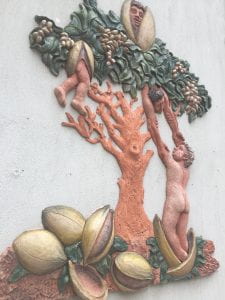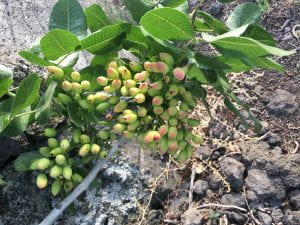Italy…known for food, wine, olive oil and many other cultural treasures, it is the site where IU Food Institute and Geography researchers are working to better understand the Geographical Indication labels and how they may be applied in the US and Indiana. GI labels let consumers know that their parmesan cheese, for example, was raised and processed in the region of Parma, Italy, for global export. They are regulated by an authority and are only given when a food product accurately represents a specific region’s history, culture, soils, climate, quality, and other attributes.

Drs. Angela Babb and Dan Knudsen are working on the ‘Sicily Project‘ and we took some time to learn more about Angela and her work. [Original script written by Claire Frohman.]
Angela Babb is an Assistant Research Scientist with the Ostrom Workshop and Director of the Critical Food Studies Lab the IU food Institute. She is also a member of the Sustainable Food Systems Science group and an alumna of IU’s Geography Department.
Q: Please tell us a bit about your primary focus areas of research.
A: A lot of my work has to do with food justice and equitable pathways to a sustainable food system. I do a lot of work on food assistance program evaluation, particularly the SNAP program, and a lot of work on the politics of hunger and the political economy of hunger.
Q: I understand you’ll be traveling to Sicily this June for fieldwork. Can you tell us a bit about that project and what your plans are?
A: This is a project that precedes me. I joined in 2018, and it’s a team of geographers looking at the Geographical Indication (GI) schemes that are used in Europe. Specifically, we’ve been looking in Sicily at how GI labels are used to protect traditional agricultural crops and methods and cultural foodways.
 GIs are labels that are put on commodities to signify that they are exceptional because they are from a particular region – that the geography of that region makes it ideal for growing that particular crop or producing a particular value added good because of the soil, the climate, the local knowledge, the cultural celebration around that particular commodity, etc. The team I joined was already looking at the green pistachio of Bronte, and in 2019 we started looking at the lemon of Siracusa and the new carrot of Ispica. The green pistachios of the Bronte region are grown in the lava rock soils around Mount Etna. For the people here, this factors a lot into their identity. Their culture really wraps around the pistachio. It’s difficult to grow in their unusual geography, so they’ve come up with a way to graft these pistachio trees and grow this incredible plant. Part of the magic is that there aren’t many other options, but they’ve found a way to grow these beautiful purple and green pistachios.
GIs are labels that are put on commodities to signify that they are exceptional because they are from a particular region – that the geography of that region makes it ideal for growing that particular crop or producing a particular value added good because of the soil, the climate, the local knowledge, the cultural celebration around that particular commodity, etc. The team I joined was already looking at the green pistachio of Bronte, and in 2019 we started looking at the lemon of Siracusa and the new carrot of Ispica. The green pistachios of the Bronte region are grown in the lava rock soils around Mount Etna. For the people here, this factors a lot into their identity. Their culture really wraps around the pistachio. It’s difficult to grow in their unusual geography, so they’ve come up with a way to graft these pistachio trees and grow this incredible plant. Part of the magic is that there aren’t many other options, but they’ve found a way to grow these beautiful purple and green pistachios.
This year we will be spending more time on the lemon of Siracusa and the new carrot of Ispica, and we’re also going to look into the tomato of Pachino. This is another interesting case study because the GI label for the Pachino tomato requires that they are grown in greenhouses, which sounds a little ironic to us, so we’re curious to research that.
Q: What would you say is your primary role in the research team?
A: As the only female team member, one of my roles has been to interview women throughout the supply and value chains we are researching to try to get an understanding of the differences in experience that might exist along gender lines in the growing or processing of these different GI labeled crops.
We’re examining how their jobs might differ, how their wages differ, how land ownership differs across lines of gender. Something I found in the process is that there are a lot of interesting questions around race, ethnicity, and citizenship status to be explored as well.
When looking at these different value chains, it’s interesting to ask what equity or inequity might be maintained by these GI labels. They are meant to protect a traditional way of doing things, and the traditional way oftentimes involves the exploitation of different populations categorized by gender, race, ethnicity, and citizenship status. We are digging into that.
Q: Is this your first time to Sicily?
A: In 2019 we went for a few weeks and interviewed the leaders of the different coalitions representing these different GI labels. Typically, a group of producers and processors will form a sort of coalition to sell their commodities with this label to standardize production, the marketing of it, etc. There is strength in numbers. We met with a lot of administrators and a few farmers and processors.
This time I’m hoping we can talk to more people with different positions throughout the value chain. I really would like to talk to more farmers and farm workers, and people doing different types of labor throughout these processing facilities, not just the managers and administrators.
Q: Do you foresee any barriers to reaching the people or asking the questions that you’re wanting to ask this time around?
A: The biggest barrier is always language. The people who are working throughout a lot of these different value chains are immigrants to Sicily and don’t necessarily speak Italian. There’s also the question of Sicilian which is already a barrier to start with. Some laborers don’t speak Italian or Sicilian, so it’s going to be really hard for us to find ways to speak with or to understand the experiences of those individuals.
It seems easy enough for me to pull aside a group of just women and talk about gender issues but, at the same time, there were moments on the last visit where I felt as though there wasn’t enough trust between us for folks to be really honest with me about their experiences. At the very least there was a little bit of disconnect in my cultural understanding of what constituted a gender issue for Sicilian or immigrant women versus what I would consider discrimination or gender discrimination from where I’m situated in my culture. I’m hoping to better understand that this time around and to not pass on my thoughts and cultural biases around what equity looks like.
Q: Who are your community partners there in Sicily and on the project in general?
A: Our colleague Gianni Petino from the University of Catania is already there and getting things all set up so we can hit the ground running. Donata Napoli is also in Sicily and helps me interpret and conduct interviews with women. Then we work with Jeffrey Wilson who’s in Geography at IUPUI, and Carl Ipsen in the History Department here at IU brings the language fluency and the cultural competency. Last but not least, Dan Knudsen is professor emeritus of the IU geography department and has been our visionary leader on the project.
Q: What is the trajectory of the project from here?
A: After we go there this June, Gianni and Donata are coming here in August and we’re going to look at some value chains here in the US. The ultimate goal is to understand the GI scheme’s potential for building sustainable and equitable food systems. Essentially, we are curious what lessons we can learn from this mechanism working in Sicily and in Europe more broadly and bring to the US to apply in places like the Indiana Uplands Region.
For instance, there is a lot of cattle raising here. Is there potential for a GI labeling system of some sort there? Could that help with meeting production here, protect some of our cultural foodways, increase consumer demand for Uplands beef?
Q: So, the main question seems to be how this labeling system could be applied in the US and potentially even improved upon. For instance, if equity is not actually a part of how it’s currently functioning in Sicily, how could measures that support equity be woven into a new framework here?
A: Yes. Or combined with something like Fair Trade labels for something more comprehensive – something that takes into consideration more than just tradition or physical geography and ultimately concerns how we protect the laborers. Still considering things like physical geography and climate change, GI labels could tell us about where different types of food should be produced – what would be the most sustainable way to grow pistachios or lemons for instance. There are all these different strategies that are being threatened by climate change, so we have to figure out, in terms of sustainable food systems, where the best place is for us to be producing some of the foods that we rely on.
Q: If someone were shopping at a grocery store like Kroger or Fresh Thyme, what might they find with one of the labels that we’re talking about?
I’ve been seeing a lot of olive oils with a PDO labels (Protected Designation of Origin), though that’s a different industry – Carl Ipsen could say much more about Italian olive oil. It is more often the shelf stable products that make it here. I tend to shop at Aldi and see random GI labels there often.
A lot of geographic identification has kind of lost its meaning in the U.S., with things like Parmesan, which theoretically originates in Parma in Italy, or Champagne which in theory should be just from the Champagne region of France. People can buy pre-grated cheese in a plastic can that’s called “parmesan” when it clearly is not a true Parmesan from Parma. Or there might be a cheese with a label with a very detailed map of Italy and an Italian flag that says “inspired by Italy” somewhere in small print, and if you’re not looking closely, you might think it was imported. Any conversion of this model to the U.S. will be difficult but interesting.
Q: Any final thoughts you would like to cover?
A: Something we haven’t looked at, which could be super interesting, is whether, on the consumer side of things, people care about GI labels. Some Sicilian farmers are saying that they have more business when using the “organic” label than their GI labels. The organic label is meaningful globally, but their GI labels still feels more like a thing of only local significance. So, another question is what makes sense globally. What labels might make sense globally from a consumer’s perspective? What would make consumers pay attention to those labels?
Overall, the big question is not only about how we can protect laborers and cultural foodways, but how are we going to be moving towards a sustainable food system equitably.
Leave a Reply